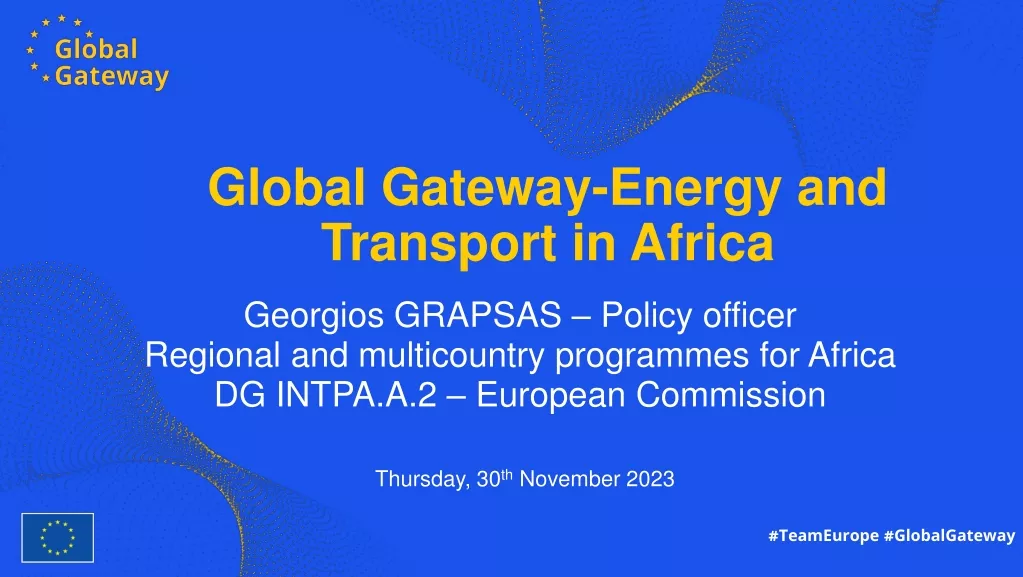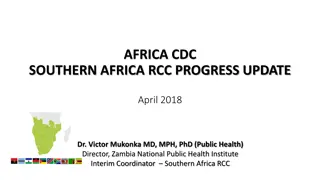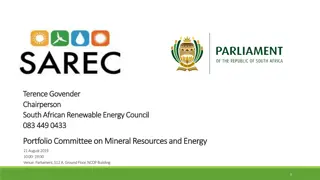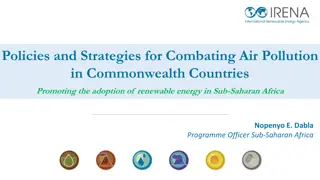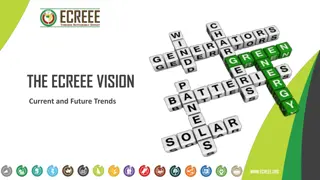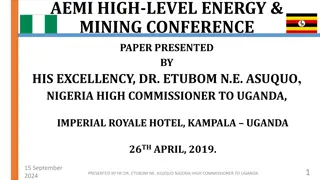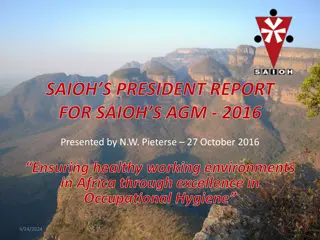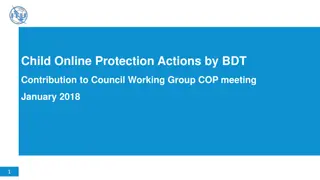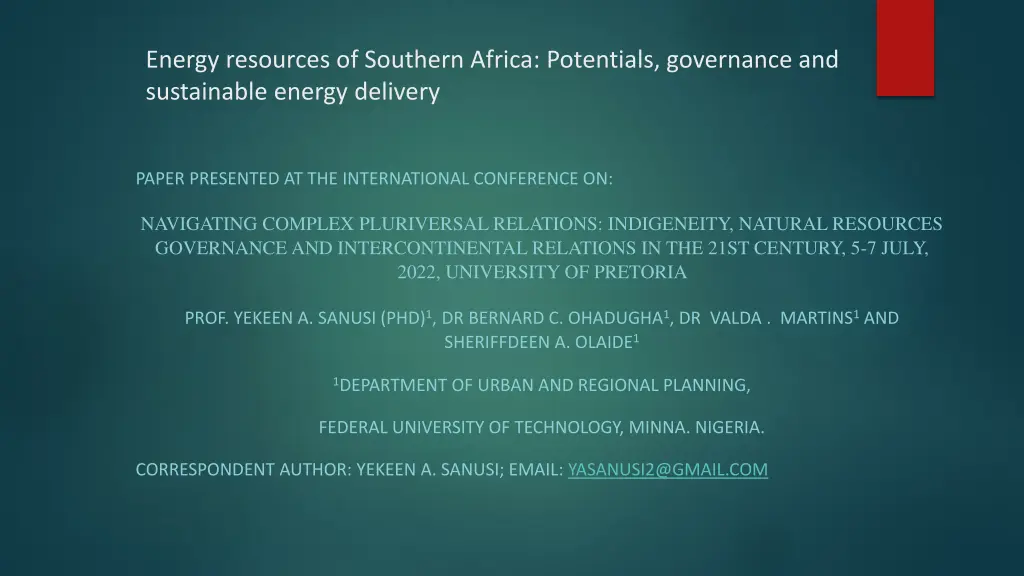
Sustainable Energy Resources in Southern Africa
Explore the potentials, governance, and sustainable delivery of energy resources in Southern Africa through a comprehensive paper presented at an international conference. The research delves into the challenges, status, potentials, and governance actions related to energy resources, aiming to offer insights for sustainable development in the region.
Download Presentation

Please find below an Image/Link to download the presentation.
The content on the website is provided AS IS for your information and personal use only. It may not be sold, licensed, or shared on other websites without obtaining consent from the author. If you encounter any issues during the download, it is possible that the publisher has removed the file from their server.
You are allowed to download the files provided on this website for personal or commercial use, subject to the condition that they are used lawfully. All files are the property of their respective owners.
The content on the website is provided AS IS for your information and personal use only. It may not be sold, licensed, or shared on other websites without obtaining consent from the author.
E N D
Presentation Transcript
Energy resources of Southern Africa: Potentials, governance and sustainable energy delivery PAPER PRESENTED AT THE INTERNATIONAL CONFERENCE ON: NAVIGATING COMPLEX PLURIVERSAL RELATIONS: INDIGENEITY, NATURAL RESOURCES GOVERNANCE AND INTERCONTINENTAL RELATIONS IN THE 21ST CENTURY, 5-7 JULY, 2022, UNIVERSITY OF PRETORIA PROF. YEKEEN A. SANUSI (PHD)1, DR BERNARD C. OHADUGHA1, DR VALDA . MARTINS1AND SHERIFFDEEN A. OLAIDE1 1DEPARTMENT OF URBAN AND REGIONAL PLANNING, FEDERAL UNIVERSITY OF TECHNOLOGY, MINNA. NIGERIA. CORRESPONDENT AUTHOR: YEKEEN A. SANUSI; EMAIL: YASANUSI2@GMAIL.COM
Outline Introduction: resources, energy resources; energy challenges; objectives Energy resources and Energy Governance Methodology Results: Energy Status Energy Potentials Energy Governance Action Conclusion Recommendations
Introduction: Natural resources Materials in the environment naturally formed and valuable for use by human beings. Constitute a significant part of the national wealth of most nations They are (1) part of the environment (2) formed naturally and (3) are useful to man. Occur in varying forms and volumes across space. Provide support ecological services for both the human society and the environment.
Introduction: Natural resources Occur in single form or in complex, and separated through human technologies. Classified as renewable or non renewable resources. Contribute to sustainability. Sustainable development: Sustainable development seeks to meet the needs and aspirations of the present without compromising the ability to meet those of the future (Brundtland Commission, 1987) a systems approach that incorporates environment, economy and society; (Rajovic and Bulatovic, 2017).
Energy resources Challenges facing energy resources in Southern Africa: Meaning Energy resources are part of the natural resources available to man. Underdevelopment resources resulting in: of these Energy resources serve three broad functions. Low energy generation capacity Serve as exportable commodity to nations and (i) low per capita energy consumption and (ii) they provide direct use to the nations for developing energy output that provide a range of services to the people. High level of deprivation in energy services (iii) Intangible advantages: pride, confidence and enhanced international diplomacy. consisting of national
Paper Objectives examine consumption, the present status of energy explore the energy potentials of Southern Africa and understand the governance activities pursued to resolve the energy challenges.
Energy Resources and Energy Governance Energy resource development is influenced by quality of governance Governance is about stewardship of formal and informal rules of political system Measures of setting rules and their enforcement Negotiation of interest and resolution of conflicts Service delivery Effective use of institutional mechanisms to effect positive changes Getting political machinery to work
Energy governance Purpose Persistent energy poverty, Meaning corruption in the management of fossil fuel resources, Energy response of the managers of the energy sector to the pervasive application of governance principles to all aspects of human society. governance is a practical threats to global energy supply, increasing players in the energy sector the task of energy transition All actions and processes engaged by both state and participating in the delivery of the energy system, to negotiate and resolve all matters and interests concerning the energy system along its value chain. the increasingly complex nature of the energy market. non-state actors, pressure of increased energy demand agitations for fair deal by the prospective consumers, and the increasing role of non-state actors.
Aspects of energy governance Trade Energy Security Climate Change Energy Governance Energy Transition investment Source: Leal-Arcas and Filis (2013)
Methodology: Energy potential: Solar potential is measured by global horizontal irradiation (GHI) and practical solar potential (PVOUT): the power output achievable by a typical PV system Non-renewable natural oil, natural gas, coal and uranium energy resources: Renewable resources: Wind, solar, hydropower and geothermal Wind energy potential is measured by wind density and wind speed Data on the non-renewable resources, hydropower and geothermal are available in the directly usable form at the country level. Data for solar energy was derived from Global Solar Atlas and that of the wind was also derived from Global Wind Atlas.
Methodology Other actions considered are the independent power providers, Power Africa, Actions by the African Union and African Development Bank and the Southern African Power Pool Energy governance actions: Data Analysis: Energy policies Descriptive process 13 policy options categorized as renewable energy targets;(2) renewable energy in Nationally Determined Contributions; (3) Renewable energy policies and (4) Fiscal incentives and public financing. comparing countries and making classifications. Some ranking was also done and leading countries in respect of each energy type identified. .
Results: Status of Energy Access Basic statistics of energy access Basic statistics Energy access(tota l) % population Energy access(urba n) % population Energy access(rural ) % population Least Urban- rural disparity Electricity consumption per (KWH/annum) 93.1 of of of capita Minimum 11.2 45.5 4.1 0 Maximu m 3539.8 100 100 100 67.6 1109.8 54.9 77.2 38.7 38.7 Mean
Results: Status of Energy Access Three best performing countries in the energy access variables Rank Energy access(tot al) population Energy access(urb an) population Energy access(rura l) % population Least Urban- rural disparity Electricity consumption per (KWH/annum) South Africa % of % of of capita 1 Mauritius Mauritius Mauritius Mauritius 2 Mauritius South Africa Swaziland South Africa South Africa 3 Namibia Botswana Swaziland Swaziland Sao Tome
Natural Gas Energy potential: Non-renewable energy: Natural gas reserves: Southern Africa has been least represented in Africa. Recent discoveries: The non-renewable energy resources considered are natural oil, natural gas, coal and uranium. Southern African countries are not generally oil sub-region. Angola: (373.8 billion cubic metres) 13.5 trillion cubic feet (tcf) Natural Oil: Only Angola features among the 12 major oil countries of Africa. Angola is the fourth largest oil country in Africa, following Libya, Nigeria and Algeria. Records show that Angola has 11.6 billion barrels of oil reserves representing about 9% of Africa's total reserves of 128 bbl Mozambique: 77.2tcf (2.2 trillion cubic metres). Shale Gas South Africa: 390tcf (11 tcm) and potential power generation of 40 854 TWh, it follows China, USA, Argentina and Mexico in that order New Oil discoveries: Mozambique: 120 billion barrels
nearest 100 tonnes. Energy potential: Non-renewable energy: : Reasonably assured recoverable Uranium resources 1 (January, 2019), tones U, rounded to nearest 100 tonnes. Coal reserves in Southern Africa Country Reserves (million tonnes) 40 Country USD260/kg U 20400 Botswana 3.28 Botswana Malawi 9700 1.56 Malawi 2 Namibia 320000 51.42 Mozambique 212 South Africa 258000 41.46 South Africa 30 156 Zambia 12800 2.05 Swaziland 200 Zimbabwe 1400 0.22 Zambia 10 Regional total 622300 100 Zimbabwe 502 Source: OECD, 2020. Source: World Energy Council, 2013
Energy Potential; Renewable Energy Solar energy potential Wind energy potential Basic statistics Wind speed m/s Basic statistics GHI (kwh/m2/y ear 1540. PVOUT (kwh/kw p/year) 1235.33 Wind density w/m2 Minimum 4.65 1985.05 Minimum 97 2367.9 Maximum 9.26 1687.45 936 Maximum Mean 1973.11 375.9 Mean 6.98 Source: Data from Global Solar Atlas, 2022. Source: Data from Global Wind Atlas, 2022.
Energy Potential; Renewable Energy Southern Africa large hydropower potential region Installed capacit y (MW) On-going constructi on (MW) Current generatio n (GWh) Technicall feasible potential (GWh) 303 715 Installed/ potential (%) Southern Africa Africa Percentage of total Source: Hydropower News: https://www.andritz.com/hydro-en/hydronews/hydropower-africa/east- africa# 10 051 3 921 43 348 14.3 32853 30.6 13327 29.4 104602 41.4 1546314 19.6 6.8 Africa
Energy Potential; Renewable Energy Geothermal: Small Hydropower Capacity and Potential of Southern Africa (MW) Two Southern African countries have geothermal resources; Zambia and Malawi. Zambia: 2 major prospects: Kapisya with more than 80 occurrences of hot springs and Kafue which lies at the intersection of the Zambezi mobile belt. 227.68 Malawi where geothermal system is due to deep circulation along structures giving rise to medium to low temperature geothermal resources 3906.6 Capacity
Energy Governance Actions: Policies Energy Policy Options by Southern African Countries PIG 9 EPP 1 TC 2 CT 6 Tend 8 REC 0 RH 3 BF 5 NMB 0 QO 2 FIT 4 RE in NDC 9 RET 12 0 2 4 6 8 10 12 14
Energy Governance Actions Power Africa Supported Electricity (MW) 37 10 98 208 Independent power producers (IPPs); According to Eberhard, et al (2017), there were 92 IPPs in Southern Africa by 2017. They account for about 5.2GW of electricity. Power Africa: An international partnership for energy development in Africa is Power Africa and an initiative of the government of USA. 3180 By the end of 2021, nine of the 12 Southern African countries are already connected to Power Africa. Malawi Namibia South Africa Swaziland Zambia Compiled https://wwwusaid gov/powerafrica from USAID, 2022.
Energy Governance Actions Continental actions: African development Bank and the African Union. New deal on Energy for Africa; 160GW new capacity by 2025; Aim: to support African countries in their efforts to provide energy for all and provide opportunities for low carbon energy development On-grid connections that will create 130 million new connections by 2025; Ooff-grid connections to add 75 million new connections through isolated mini-grid and standalone systems; transmission and good Africa Renewable Energy initiative: Achieve 10GW of new energy capacity at the end of 2020, Access to clean cooking energy for about 150 million households by 2025 Renewable energy generation of 30GW by 2030.
Energy Governance Actions Southern Africa Regional power Pool Formed in 1995 with member countries of Angola, Botswana, Democratic Republic of Congo (DRC) Lesotho, Madagascar, Malawi, Mauritius, Mozambique, Namibia, Seychelles, South Africa, Swaziland, Tanzania, Zambia and Zimbabwe. Aim: to achieve a fully integrated, competitive energy market and a provider of sustainable energy solutions for the SADC region and beyond
Energy Governance Actions: Southern Africa Power Pool Achievements: Between 2011-2019: 24,488 MW new generation capacity By 2020, the Power Pool provided 9,817 MW in excess capacity, mainly from South Africa (7,959MW) and Angola (2,261MW). In 2020/21 operating year: USD91.1 million was realised in total revenue that was exchanged between members; 8 205.31 GWh was traded through bilateral contracts and competitive market; 1498.55GWh was traded on the competitive market while 6707.76GWh was traded through Bilateral Contracts.
Conclusion: The energy potential of the Southern African countries are enormous and offer opportunities for changing the fortunes of the energy access in these countries. Increasing discovery of fossil fuels in the sub-region will provide opportunities for export and earning of foreign exchange and provide employment. Problems of fossil fuel development: High level of emission; declining internationall support for fossil fuel energy development; international protest and even some local protest; the danger of other environmental hazards including resource depletion, the danger of fossil fuel trap.
Conclusion: The advantages of natural gas should be recognised and hence stands useful for energy generation and domestic cooking energy use. There is clear evidence of energy deprivation in the midst of plenty; raising the issue of resource curse. The existing governance initiatives are many, but the tangible contributions are low. Renewable energy option stands in very good stead to shield the Southern African countries from the largely unsustainable fossil fuels.
Recommendations Sustainable energy resource development will involve: Sound care for the environment, People-centred energy system; Spatial justice that recognises all places Economic gains that involve employment generation, thriving private sector investment, Functioning utilities, A mix of centralised generation and distribution system and Fulfilling international energy transition and climate change agreements.


